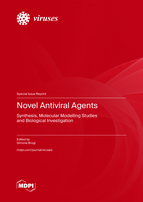Novel Antiviral Agents: Synthesis, Molecular Modelling Studies and Biological Investigation
A special issue of Viruses (ISSN 1999-4915). This special issue belongs to the section "Viral Immunology, Vaccines, and Antivirals".
Deadline for manuscript submissions: closed (30 June 2023) | Viewed by 26311
Special Issue Editor
Interests: in silico pharmacology; computational toxicology; computer-aided drug design; modelling and simulation; infectious diseases
Special Issues, Collections and Topics in MDPI journals
Special Issue Information
Dear Colleagues,
Infectious diseases continue to be one of the major causes of human and animal morbidity and mortality, accounting for ~20% of global death. Among them, viruses are responsible for about one-third of these deaths. During the last two decades, emerging and re-emerging viruses, such as the recent SARS-CoV-2 as well as related coronaviruses (SARS and MERS), avian influenza A (H5N1, H1N1, and H7N9) viruses, Zika virus, and enteroviruses, have posed significant global public health threats. Accordingly, the necessity to identify innovative antiviral agents, vaccines, novel therapeutic approaches based on drug repurposing, and novel strategies for early diagnosis and prevention are urgently needed, also considering the possibility of future outbreaks. In this scenario, computational procedures, including innovative machine learning approaches, could accelerate the discovery of effective antiviral agents and therapeutic strategies. To this end, we cordially invite researchers working in the antiviral drug discovery field, with a special focus on computer-aided drug discovery and molecular virology, to submit original research articles, short communications, and review articles related to the discovery of novel antiviral agents.
Dr. Simone Brogi
Guest Editor
Manuscript Submission Information
Manuscripts should be submitted online at www.mdpi.com by registering and logging in to this website. Once you are registered, click here to go to the submission form. Manuscripts can be submitted until the deadline. All submissions that pass pre-check are peer-reviewed. Accepted papers will be published continuously in the journal (as soon as accepted) and will be listed together on the special issue website. Research articles, review articles as well as short communications are invited. For planned papers, a title and short abstract (about 100 words) can be sent to the Editorial Office for announcement on this website.
Submitted manuscripts should not have been published previously, nor be under consideration for publication elsewhere (except conference proceedings papers). All manuscripts are thoroughly refereed through a single-blind peer-review process. A guide for authors and other relevant information for submission of manuscripts is available on the Instructions for Authors page. Viruses is an international peer-reviewed open access monthly journal published by MDPI.
Please visit the Instructions for Authors page before submitting a manuscript. The Article Processing Charge (APC) for publication in this open access journal is 2600 CHF (Swiss Francs). Submitted papers should be well formatted and use good English. Authors may use MDPI's English editing service prior to publication or during author revisions.
Keywords
- antiviral agents
- in silico tools
- emerging infectious diseases
- viruses







